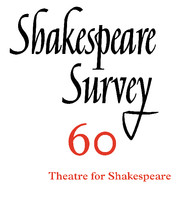Book contents
- Frontmatter
- Professional Players in the Guild Hall, Stratford-upon-Avon, 1568–1597
- Reconstructing The Rose: Development of the Playhouse Building between 1587 and 1592
- The Rose and its Stages
- Philip Henslowe and the Elizabethan Court
- From Revels to Revelation: Shakespeare and the Mask
- Bride-ing the Shrew: Costumes that Matter
- ‘When Men and Women are Alone’: Framing the Taming in India
- The Crown and the Pillow: Royal Properties in Henry IV
- Humanity at Stake: Man and Animal in Shakespeare’s Theatre
- Popular Shakespeare in Japan
- ‘Philosophy in a Gorilla Suit’: Do Shakespearians Perform or Just Perform-a-tive?
- Sudokothellophobia: Writing Hypertextually, Performatively
- Living Monuments: The Spatial Politics of Shakespeare’s Rome on the Contemporary Stage
- ‘In Windsor Forest and at the Boar’s Head’: The ‘Falstaff Plays’ and English Music in the Early Twentieth Century
- Michael Bogdanov in Conversation
- The Mouse and the Urn: Re-Visions of Shakespeare from Voltaire to Ducis
- ‘I covet your skull’: Death and Desire in Hamlet
- Martin Droeshout Redivivus: Reassessing the Folio Engraving of Shakespeare
- Canonizing Shakespeare: The Passionate Pilgrim, England’s Helicon and the Question of Authenticity
- Rereading Shakespeare: The Example of Richard Brathwait
- Shakespeare Performances in England, 2006: January 2006
- Professional Shakespeare Productions in the British Isles January–December 2005
- he Year's Contributions to Shakespearian Study 1 Critical Studies
- 2 Shakespeare in Performance
- 3 Editions and Textual Studies
- Index
From Revels to Revelation: Shakespeare and the Mask
Published online by Cambridge University Press: 28 November 2007
- Frontmatter
- Professional Players in the Guild Hall, Stratford-upon-Avon, 1568–1597
- Reconstructing The Rose: Development of the Playhouse Building between 1587 and 1592
- The Rose and its Stages
- Philip Henslowe and the Elizabethan Court
- From Revels to Revelation: Shakespeare and the Mask
- Bride-ing the Shrew: Costumes that Matter
- ‘When Men and Women are Alone’: Framing the Taming in India
- The Crown and the Pillow: Royal Properties in Henry IV
- Humanity at Stake: Man and Animal in Shakespeare’s Theatre
- Popular Shakespeare in Japan
- ‘Philosophy in a Gorilla Suit’: Do Shakespearians Perform or Just Perform-a-tive?
- Sudokothellophobia: Writing Hypertextually, Performatively
- Living Monuments: The Spatial Politics of Shakespeare’s Rome on the Contemporary Stage
- ‘In Windsor Forest and at the Boar’s Head’: The ‘Falstaff Plays’ and English Music in the Early Twentieth Century
- Michael Bogdanov in Conversation
- The Mouse and the Urn: Re-Visions of Shakespeare from Voltaire to Ducis
- ‘I covet your skull’: Death and Desire in Hamlet
- Martin Droeshout Redivivus: Reassessing the Folio Engraving of Shakespeare
- Canonizing Shakespeare: The Passionate Pilgrim, England’s Helicon and the Question of Authenticity
- Rereading Shakespeare: The Example of Richard Brathwait
- Shakespeare Performances in England, 2006: January 2006
- Professional Shakespeare Productions in the British Isles January–December 2005
- he Year's Contributions to Shakespearian Study 1 Critical Studies
- 2 Shakespeare in Performance
- 3 Editions and Textual Studies
- Index
Summary
Shakespeare’s late plays are often rightly said to be influenced by masque. The context for such influence is the sumptuous Jacobean masque, a series of performances particularly encouraged by Queen Anne from 1604, in which Shakespeare’s company, the King’s Men, usually took the speaking parts. This kind of masque is associated with the literary, classically inspired and often arcane writing of Ben Jonson and others, with the development of the scenic stage, the proscenium arch and perspective staging under the direction of Inigo Jones, and with the famous quarrel between Jonson and Jones as to whether poetry or picture should be considered the true ‘soul’ of masque. Its influence on Shakespeare is also often linked to the King’s Men’s move to the Blackfriars in 1609, an indoor theatre which may have encouraged a different approach to stage spectacle, though the late plays continued to be performed at the outdoor Globe as well as the newly acquired Blackfriars. To date, however, Tudor mask has been the poor relation both in Shakespeare studies and in studies of court theatre more widely. The distinction in spelling (mask versus masque) signals a widespread concern to mark a boundary between the two forms, implicitly suggesting that the later form is different, perhaps more grown-up, more sophisticated, more literary and certainly more worthy of critical attention, than its primitive forebear, despite the fact that the later form remains strongly indebted to the earlier. Yet the influence of Tudor mask on Shakespeare’s Elizabethan plays cannot be denied, though it has traditionally been only grudgingly admitted, as in John Dover Wilson’s expressed discomfort with the mask of Hymen in As You Like It: ‘There is no dramatic necessity for this masque-business.’
- Type
- Chapter
- Information
- Shakespeare Survey , pp. 58 - 71Publisher: Cambridge University PressPrint publication year: 2007

